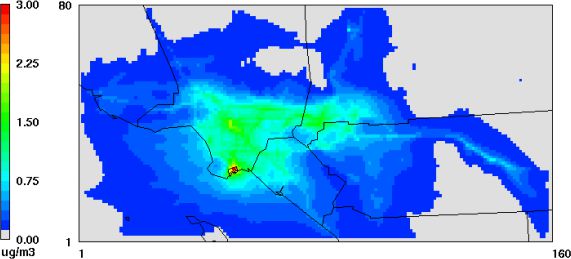California MATES IV study: Cancer risk from air toxics reduced by 65%
14 October 2014
California’s South Coast Air Quality Management District (SCAQMD) has released a Draft Report from the Multiple Air Toxics Exposure Study IV (MATES IV)—a comprehensive air quality study focused on the carcinogenic risk from exposure to air toxics in the California South Coast Air Basin. Based on the exposure levels from the 10 monitoring sites used in the study, the average cancer risk from air toxics in the South Coast Air Basin is 67% lower than the estimated risk from the 2004-2006 time period.
The MATES IV Study included a monitoring program, an updated emissions inventory of toxic air contaminants, and a modeling effort to characterize risk across the South Coast Air Basin. The study is a follow-up to the MATES III study completed in 2008.
The study measured 37 substances, including PM10, PM2.5, several organic compounds (formaldehyde, benzene, toluene, PAHs,...), heavy metals (Mn, Cu, Pb, Ni,...), and other compounds. Two new substances—black carbon (BC) and ultrafine particles (UFP)—not monitored in previous MATES studies were included in the MATES IV measurement program.
Concentrations of diesel particulates, singled out as a major contributor to the cancer risk, were calculated based on the measured elemental carbon (EC) exposures which were adjusted by the ratio of emissions of EC and diesel PM from the emissions inventory estimates. This indirect method of estimation of diesel PM exposures is one of the major sources of uncertainty in the study.
Although the estimated Basin-wide risks declined from the MATES III period, areas near the ports and near transportation corridors continue to show the highest air toxics risk, emphasized the authors of the MATES IV study. Some of the key findings of the study are:
- The average Basin cancer risk from air toxics based on the annual average levels calculated from the 10 monitoring sites data was approximately 418 per million—about 65% lower than the estimated risk from the 2004-2006 time period.
- According to the regional modeling analysis, the highest risks from air toxics exists in areas surrounding the ports, with the highest risk about 1,000 per million, followed by Central Los Angeles, where there is a major transportation corridor, with modeled risks ranging from about 700 to 750 per million.
- The Basin-wide estimated population-weighted cancer risk was 57% lower in MATES IV compared to MATES III.
- Diesel exhaust was the key driver for air toxics risk, accounting for 68% of the total estimated air toxics risk estimated from monitoring.
- None of the annual averages of pollutants measured were above the chronic reference exposure levels (RELs) for noncancer health effects developed by OEHHA (California Office of Environmental Health Hazard Assessment).
- Ambient levels of most substances measured were lower compared to that of the MATES III Study.
- Ultrafine particle measurements at the ten fixed sites revealed that regional ultrafine levels are higher in western areas of the Basin with greater population and traffic density.
- Consistent with previous studies, short-term, local-scale measurements near a rail yard, an airport, and a busy freeway intersection showed higher diesel PM and ultrafine concentrations than the nearest fixed site monitor.
Figure 1 shows the average concentrations of diesel particulate matter modeled by the study. The highest concentration of diesel PM2.5—2.9 μg/m3—was simulated to occur around the Ports of Los Angeles and Long Beach.

Diesel PM exposures have been significantly reduced from the 2004-2006 period, due to the various diesel emission regulations and programs enacted in California and federally in the United States. In the previous MATES III study, the average ambient diesel PM concentration in the South Coast Basin was estimated at 3.2-3.49 µg/m3.
SCAQMD has released the Draft Report for a 90-day review period and will accept comments until January 5, 2015.
Source: SCAQMD